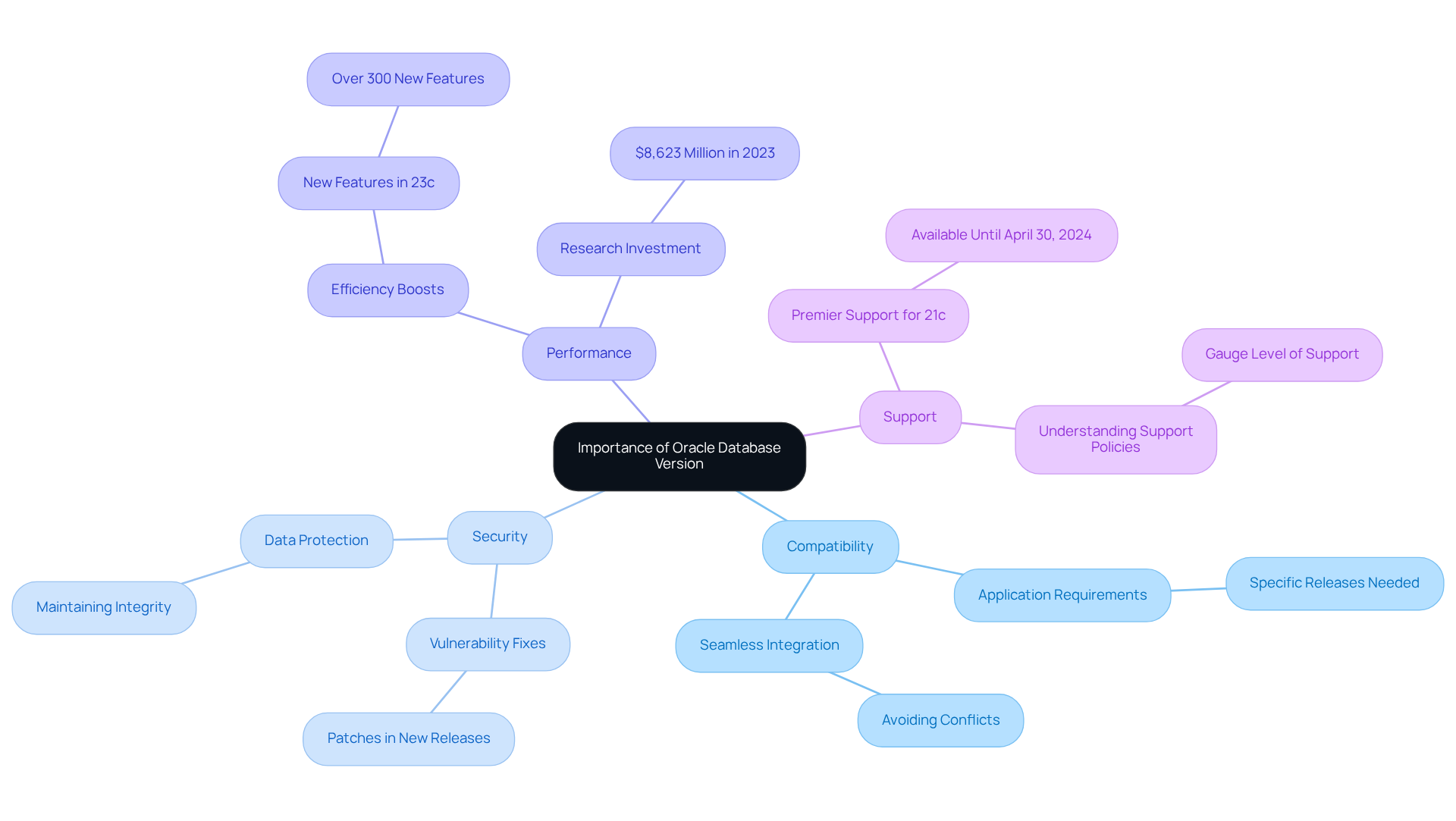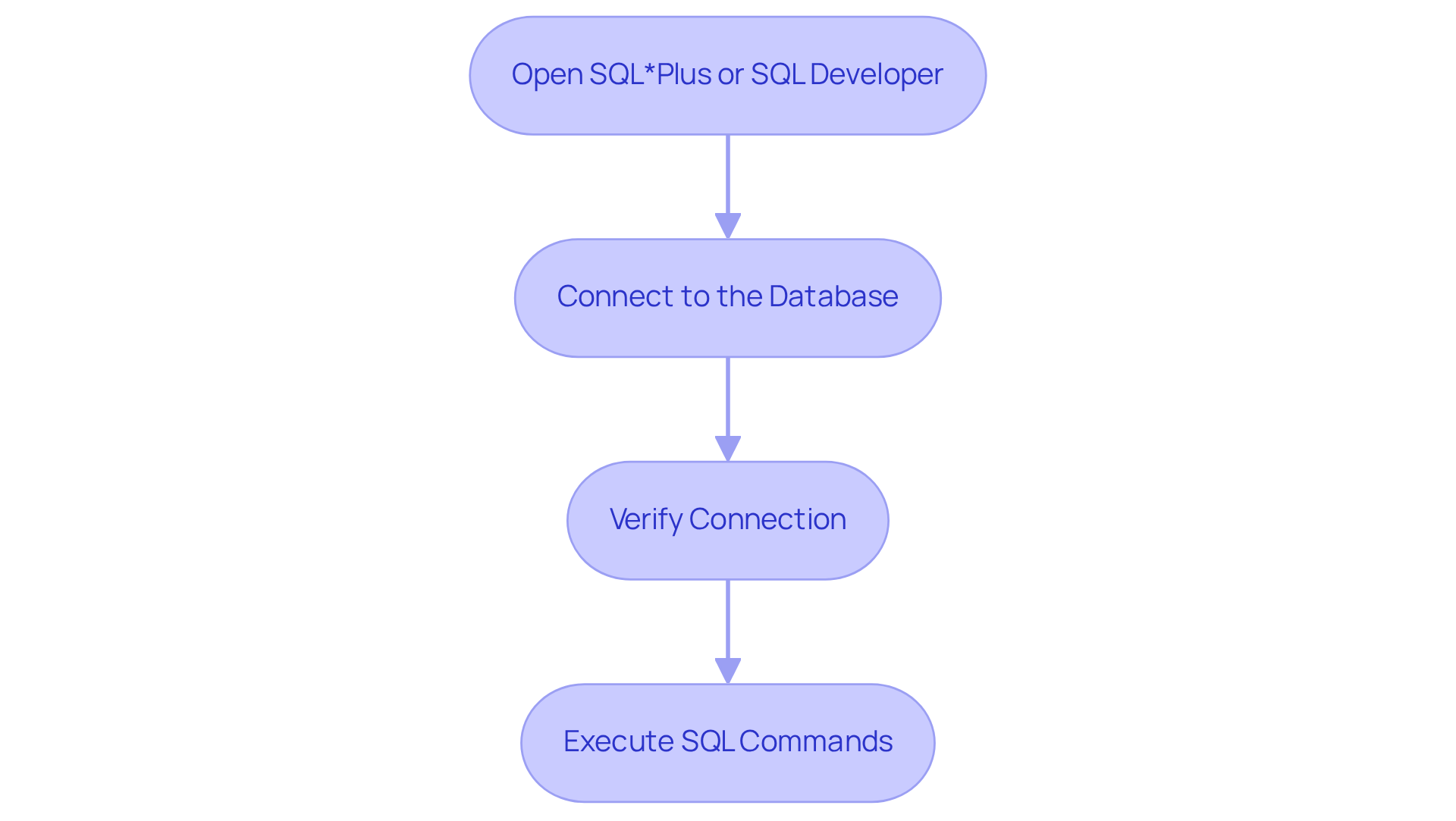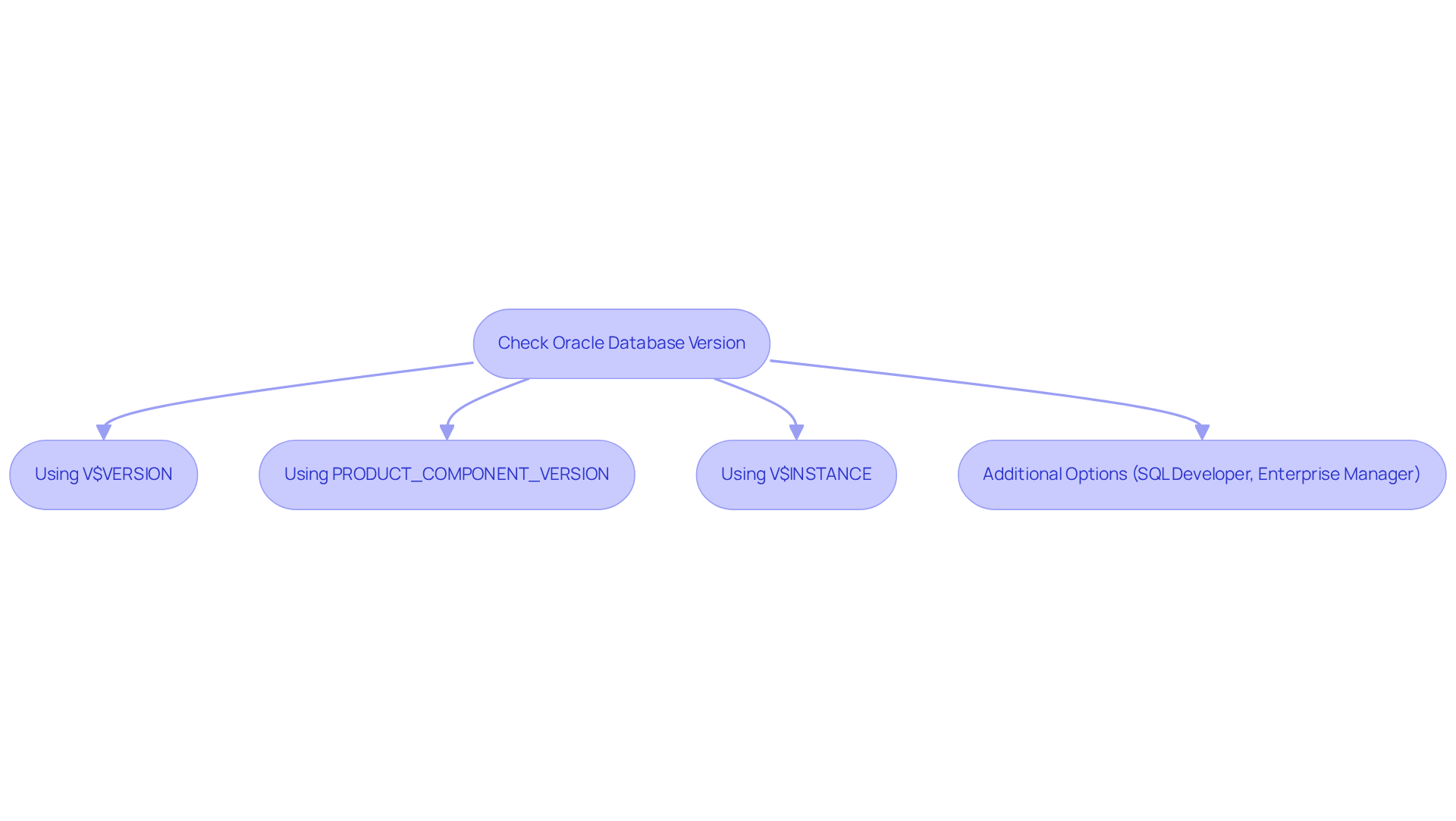
Overview
You might be wondering how to find out which version of Oracle Database you're using. Well, it’s pretty straightforward! You can run a simple SQL command like SELECT * FROM V$VERSION; or use handy tools like SQL Developer and Enterprise Manager to check the version. Knowing your database version is super important for ensuring compatibility, enhancing security, and boosting performance.
This article walks you through various easy methods to check your version, all of which support effective data management practices. So, let’s dive into it!
Key Highlights:
- Understanding the Oracle Database version is crucial for compatibility with applications and tools.
- Keeping the database updated enhances security by addressing vulnerabilities in older versions.
- Upgrading to the latest version, like 23c, improves performance with new features, including advanced JSON and microservices support.
- Oracle provides support for specific versions, with 21c support available until April 30, 2024.
- Accessing the Oracle Database requires launching SQL*Plus or SQL Developer and logging in with valid credentials.
- SQL commands such as 'SELECT * FROM V$VERSION;' can be used to cheque the current Oracle Database version.
- Alternative methods for version verification include using Enterprise Manager, data client tools like Toad, command line checks, and reviewing log files.
Introduction
You might be wondering why understanding the version of an Oracle Database is such a big deal. Well, it’s not just a technical detail; it’s actually crucial for ensuring compatibility, security, and performance. As more businesses lean on data-driven insights, knowing how to pinpoint the specific version of Oracle Database can really empower your organization to make smart decisions about upgrades and maintenance. But with so many ways to verify the version—from SQL commands to user-friendly tools—you might ask yourself: which method is the most efficient and accurate for your unique setup? Let’s dive into that!
Understand the Importance of Oracle Database Version
You might be wondering how to know Oracle Database version and why this understanding is so important. Well, let’s dive into a few key reasons that really matter:
- First up, compatibility! Different applications and tools often rely on specific Oracle Database releases to work their best. Understanding how to know Oracle Database version ensures that everything runs smoothly together, which is a big win for you.
- Next, let’s talk security. Older database systems can have vulnerabilities that newer releases fix with patches and updates. Keeping your data storage current is crucial for protecting your information and maintaining system integrity.
- Now, performance is another biggie. Upgrading to the latest version usually brings along performance boosts and new features that can really enhance your database's efficiency. For instance, those who have made the leap to version 23c are seeing amazing results, thanks to over 300 new features, including advanced support for JSON and microservices. Plus, did you know that the company invested a whopping $8,623 million in research and development in 2023? That’s a clear sign of their commitment to innovation!
- And don’t forget about support. The organization offers help for specific releases, with top-notch support for the 21c system available until April 30, 2024. Knowing how to know Oracle Database version helps you gauge the level of support you can expect, ensuring you stay in line with the company’s support policies.
In a nutshell, understanding how to know Oracle Database version is more than just a technical detail; it’s a strategic necessity for effective data management and operational excellence. So, why not take a moment to check it out?

Access the Oracle Database Environment
To access the Oracle Database environment, here’s what you need to do:
- Open SQLPlus or SQL Developer: You’ll want to launch either the SQLPlus command line or the SQL Developer application on your computer. Simple enough, right?
- Connect to the Database: When prompted, enter your username and password. Just a heads-up—make sure you have the necessary permissions to access the data repository.
- Verify Connection: After logging in, you should see a prompt that indicates you’re linked to the data source. This confirms you can now execute SQL commands.
Here’s an example command to connect using SQL*Plus:
sqlplus username/password@database
Just replace username, password, and database with your actual credentials.
Now, let’s talk about the best ways to link to the database management system. It’s crucial to keep your credentials secure, use the latest version of SQLPlus or SQL Developer, and regularly check your connection configurations. You might be surprised to know that a lot of users actually prefer SQLPlus for its performance optimization capabilities. It often provides more useful statistics compared to SQL Developer. As Ric Van Dyke pointed out, "The stats shown in SQL Plus seem to be much more useful for performance optimization over the one shown in SQL Developer." This preference really highlights how important it is to choose the right tool for effective database management.

Check Oracle Version Using SQL Commands
If you want to check the Oracle Database version, you might be wondering how to know oracle database version. Let’s dive into a few SQL commands that will help you out:
-
Using V$VERSION: This command gives you detailed release information. Just run:
SELECT * FROM V$VERSION;This will return several rows, including the Oracle Database version, release date, and other relevant details.
-
Using PRODUCT_COMPONENT_VERSION: Another handy command to get release details is:
SELECT version FROM PRODUCT_COMPONENT_VERSION WHERE product LIKE 'Oracle Database%';This will show you the version number of the Oracle Database you have installed.
-
Using V$INSTANCE: If you’re looking for another way to snag that release info, you can use:
SELECT version FROM V$INSTANCE;This command will tell you the version of the currently running instance.
After running these commands, check the output to understand how to know oracle database version. Understanding your edition is super important for ensuring compatibility with software updates and optimizing performance. Remember, understanding how to know oracle database version is crucial for making informed choices about updates and boosting performance.
And hey, if you’re looking for other ways to verify the version, consider using SQL Developer or Enterprise Manager. They can provide extra insights into your data environment, making your life a little easier!

Explore Alternative Methods for Version Verification
You might be wondering how to know oracle database version without diving deep into SQL commands. Well, there are several effective methods to do just that!
First up, let’s talk about Enterprise Manager. This handy management tool allows you to log in and navigate to the data instance. You’ll typically find the release details in the 'General' section, making it super easy to check the edition of your data repository. Industry experts often recommend using Oracle Enterprise Manager because it centralizes management and monitoring tasks, ensuring you have a reliable way to verify releases.
Next, we have Data Client Tools. Many users rely on tools like Toad or PL/SQL Developer, which often display the system release right when you connect. In fact, a significant number of database administrators prefer these tools for their user-friendly nature. Just take a peek at the connection properties or the status bar for the details—it’s a convenient choice for busy professionals like you!
If you’re on a Linux system, checking the version is a breeze with the command line. Simply run:
sqlplus -v
This command will show you the version of SQL*Plus, which usually matches up with your Oracle Database version, giving you accurate information.
Don’t forget about Log Files! Taking a look at the alert log or startup logs can also provide you with release information. These logs often include the release details when the system initializes, making them a dependable resource for confirmation. Regularly reviewing these logs is essential for ensuring compatibility and boosting performance throughout your data environment.
By using these methods, you can confidently understand how to know oracle database version through various means. Regular checks are crucial—they help maintain compatibility and optimize performance across your database environment. So, why not give them a try?

Conclusion
You might be wondering why knowing your Oracle Database version is such a big deal. Well, it’s not just a technical checkbox; it’s crucial for keeping your data management on point. Throughout this guide, we’ve highlighted how being aware of your specific Oracle Database version can really make a difference in how efficiently your operations run and how well your data holds up.
Let’s recap some key points:
- Compatibility with applications is a must.
- Security updates can’t be overlooked.
- Newer versions often come packed with performance boosts.
- Support for particular releases can save you a headache down the road.
By using SQL commands or handy tools like Enterprise Manager, you’re empowered to take charge of your databases and align with best practices.
In the end, regularly checking your Oracle Database version is essential for keeping your data environment running smoothly. Embracing these practices not only amps up performance but also strengthens your security and ensures you’re compatible with the latest tech. So, take a moment to dive into these strategies—they’ll lead you to make more informed decisions and enjoy a robust database management experience.
Frequently Asked Questions
Why is it important to know the Oracle Database version?
Knowing the Oracle Database version is important for compatibility with applications and tools, ensuring security by using updated systems, improving performance with new features, and understanding the level of support available for specific releases.
How does the Oracle Database version affect compatibility?
Different applications and tools often rely on specific Oracle Database releases to function properly. Knowing the version ensures that all components work smoothly together.
What role does the Oracle Database version play in security?
Older database systems may have vulnerabilities that newer releases address with patches and updates. Keeping the database current is crucial for protecting data and maintaining system integrity.
How can upgrading to the latest Oracle Database version improve performance?
Upgrading usually brings performance boosts and new features that enhance database efficiency. For example, version 23c includes over 300 new features, such as advanced support for JSON and microservices.
What is the significance of Oracle's investment in research and development?
Oracle invested $8,623 million in research and development in 2023, indicating their commitment to innovation and the continuous improvement of their database products.
What support is available for different Oracle Database versions?
Oracle provides support for specific releases, with top-notch support for the 21c system available until April 30, 2024. Knowing the database version helps gauge the expected level of support.
How does understanding the Oracle Database version contribute to data management?
Understanding the database version is a strategic necessity for effective data management and operational excellence, ensuring optimal performance, security, and compatibility.
👍
What others are liking
5 Steps to outline your ideal documentation structure
5 MINS READ
Where to start the your journey of mapping out your ideal documentation structure, aligning it with the very heartbeat of your organization?
Defining a winning level of detail in your process
3 MINS READ
What is too much detail, and what is too little? This article described in that winning level detail about what detail is enough.





